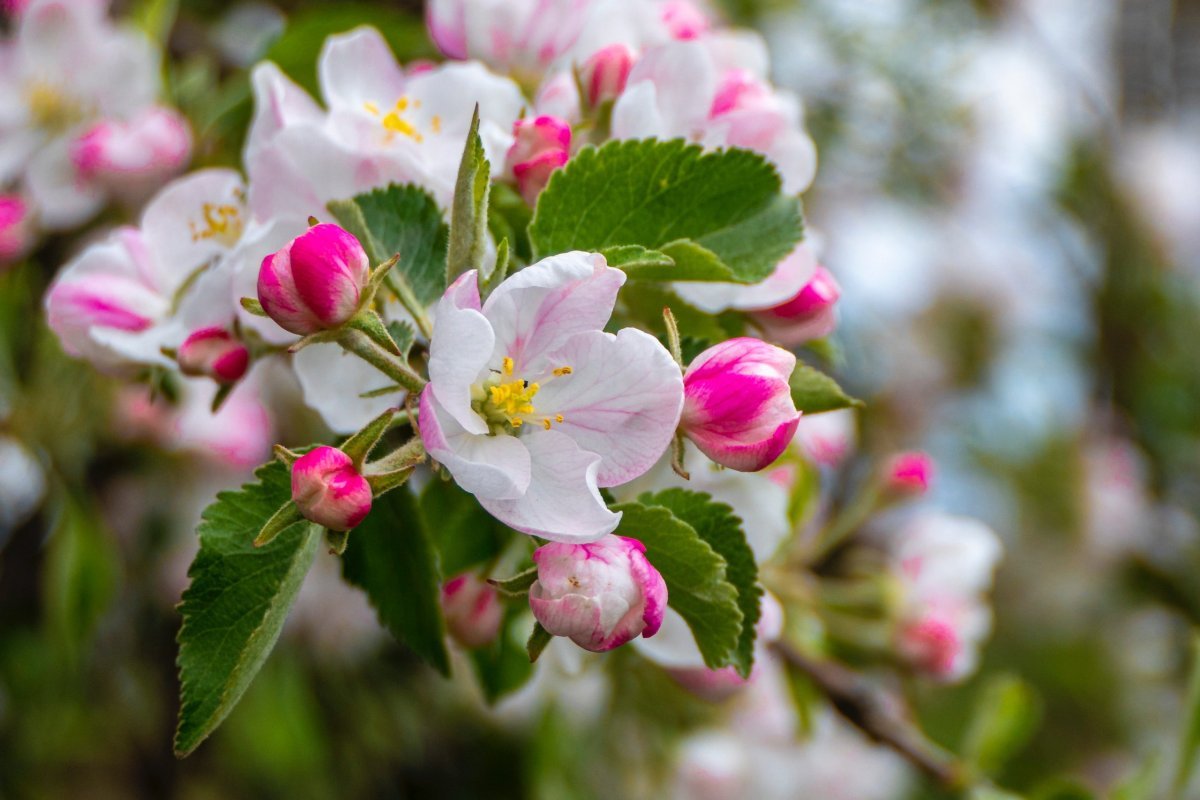Fruit trees are the high-school overachiever of the garden. They’re the “4.0 GPA, flawless skin, all AP classes, volunteers at a nursing home” type. Flowering fruit trees are the darling of any garden because they do so much! They produce delicious fruit to be snacked on, baked, frozen, or canned. They also provide shade for you and your shade-loving vegetables. Not to mention that flowering fruit trees provide gorgeous and often delicious smelling blossoms ahead of their fruiting period.
Growing fruit trees in a smaller yard is no easy feat, but it can be done! Depending on your climate, you may have better luck with indoor container fruit trees. Here in New England, my small Meyer lemon tree thrives indoors, producing sweet-smelling flowers and fruit, but I know it wouldn’t fare well outdoors during the winter months. If you do plant flowering fruit trees in your yard, take care to protect them from wildlife, like deer.
Whether you are a flowering fruit tree connoisseur or just a big-time fan, let’s take a moment to appreciate the 10 most beautiful flowering fruit trees, in no particular order.
Explore the easiest fruit to grow at home—indoors or out! Read our FREEBIE 15 Easiest Fruits to Grow at Home, right now!
Apple tree
Lush and lovely, apple blossoms have five petals each and produce a sweet scent attracting pollinators like bees. Blooms arrive between early spring to early summer, depending on location and variety of tree. Because apple trees are not self-pollinating, the trees will do much better in groups of the same variety.
Peach tree
Peach blossoms show up on the scene in singles or pairs and have no more than five petals each. The flowers appear well before the leaves and provide a stark contrast to the dark bark of the branches. Color can range from light pink (almost white) to red and even light purple depending on the variety. Peach blossoms pollinate themselves so they don’t rely on other nearby peach trees.
Pomegranate tree
Pomegranate blossoms almost look like trumpets, announcing the arrival of the uniquely shaped pomegranate. These blossoms produce red or white flowers with three to seven petals each. Like peach trees, pomegranates are self-pollinating with both male and female flowers.
Lemon tree
Lemons come from a flowering fruit tree that produces delicate, white blossoms with a touch of purple close to the base. Many varieties grow year-round and are self-pollinating. Lemon blossoms can be harvested (along with the leaves) for tea. Blossoms also make a lovely food garnish.
Guava tree flowers
An unusual looking blossom, most guava trees produce a five-petal flower with several long central stamens often pulling focus from the petals, themselves. The stamens clump together at the base and shoot out in firework formation. Guava flowers are both self-pollinating and can rely on bees and other pollinators.
Cherry tree
In many places around the world, cherry blossom season is a major signal that spring has arrived. Certain varieties of cherry trees are ornamental statement pieces, and it’s hard to ignore the abundant pink-toned blooms. Cherry blossoms and leaves can be picked and turned into different candies and teas. There are even some Japanese recipes that call for pickling the blossoms first, before using them in pastries and other baked goods.
Plum tree
Like the cherry tree, some varieties of plum trees are cultivated to be ornamental and others are beautiful flowering fruit trees. The flowers on a plum tree that will bear fruit are tiny and white, while non-fruit bearing plum trees produce tiny pink flowers. Honeybees are the main pollinators of plum trees.
Pear tree
When pear trees begin to blossom, the flowers appear green at first then turn white. These blossoms have five to seven petals and have a mild sweet scent. Pear blossoms don’t have a particular taste, however can be used as a garnish.
Persimmon tree
With the cutest little yellow flowers, the Persimmon tree can take about six years to produce fruit. Each tree has only one gender of flowers and relies on pollinators like bees to reproduce. It’s easy to spot the difference between a male persimmon tree and a female persimmon tree. Male flowers are white with a bit of green tint and grow in groups. Female flowers grow by themselves and have more yellow in them.
Orange tree
Similar in shape and color to the lemon blossoms, orange blossoms are sweet-smelling and often used in fragrances and perfumes. Like many of the beautiful flowering fruit trees, not all orange blossoms will become oranges, and many will drop from the tree after they bloom. Unlike the lemon tree, orange trees typically only produce once a season, since the fruiting period can take up to 10 months.
Which flowering fruit trees are your favorite? Do you grow any at home? Let me know in the comments!
Note: Food Gardening Network contains links to affiliate websites including Amazon and Rakuten Affiliate Network and we may receive a commission for any eligible purchases made by you through links on this page.
Explore the easiest fruit to grow at home—indoors or out! Read our FREEBIE 15 Easiest Fruits to Grow at Home, right now!

One reply on “The 10 Most Beautiful Flowering Fruit Trees”
I have All but the guava and cherry, but used to have a cherry (moved). They are all beautiful in their own way. I love The scent of the orange trees and lemon best, but the pinks in cherry, apple and red pomegranate are beautiful.